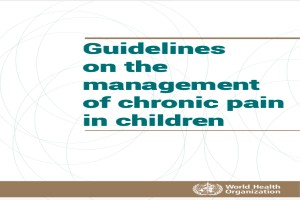
WHO issues new guidelines on the management of chronic pain in children
Geneva: New World Health Organisation (WHO) Guidelines on the management of chronic pain in children were released on February 1, 2021, to provide recommended physical, psychological and pharmacological interventions for pain relief in children aged 0-19 years. The guideline, which replaces the discontinued “WHO guidelines on the pharmacological treatment of persisting pain in children with medical illnesses” (2012), supports countries to develop and implement national and local policies, regulations, pain management protocols and best practices for pain relief.
The management of chronic pain in children is complex and challenging, and there is a paucity of high-quality research studies on treatment interventions and management approaches. Pain management requires an approach that is tailored to each individual and context, and is multimodal and interdisciplinary, requiring trained healthcare providers and a coordinated, comprehensive, integrated response.
Based on the most current scientific evidence, the recommendations include three areas of inventions: physical therapy, psychological therapy, and pharmacological management, which may include the use of morphine for end-of-life-care or when chronic pain is associated with life-limiting conditions. (WHO defines the terms “end-of-life-care” as palliative care for people in the final weeks or months of life to die with dignity, and “life-limiting conditions” as illnesses for which there is no cure and an early death is expected, but with which a person may continue to live for several more years.)
The guideline includes 10 best practice statements which apply to all aspects of the clinical care of a child with chronic pain, including the planning, implementation and delivery of physical, psychological and pharmacological interventions. For example, children with chronic pain and their families and caregivers must be cared for from a biopsychosocial perspective, recognising pain as a complex multidimensional experience resulting from biological, psychological and social factors instead of only treating pain as simply a biomedical problem.
It may be mentioned that pain is defined as an unpleasant sensory and emotional experience associated with actual or potential tissue damage. While pain with a duration of less than 3 months is referred to as ‘Acute pain’, pain that persists or recurs for longer than 3 months is seen as ‘Chronic pain’ which is multifactorial: biological, psychological and social factors contribute to the pain syndrome.
Chronic pain in children is a significant public health problem globally and a leading cause of morbidity in children, with a negative impact on their emotional, physical and social development and function. The lives of families and caregivers are also significantly impacted.
However, little is known about the global burden of chronic pain in children. Available studies suggest that about one-quarter to one-third of children experience it, with about 1 in 20 experiencing moderate to high levels of pain-related disability; and it is often a symptom of long-term conditions, such as cancer, sickle-cell disease, diabetes and arthritic conditions.
Every year almost 2.5 million children die with serious health-related suffering associated with the need for palliative care and pain relief, and more than 98% of these children are from developing regions.
Among adolescents, a systematic review reported significant variation in pain prevalence across studies, ranging from 8% to 83% for headache, 14% to 24% for back pain, 4% to 53% for abdominal pain; 4% to 40% for musculoskeletal pain and 4% to 49% for multi-site pain.
Data from low and middle-income countries are scant. In a study set in a high-income country, 6% of children have chronic pain, with a higher prevalence among older children, children from low-income families, children using public insurance and children whose parents did not complete higher education. Some studies indicate even higher rates, particularly among adolescents.
Data from WHO collaborative cross-national Health Behaviour in School-aged Children (HBSC) study based on nationally representative samples of adolescents, revealed that 44% of adolescents reported chronic weekly pain during the last six months. Predictors of pain in adolescents included age and sex, with different demographic patterns and types of pain and locations across countries.
Chronic pain can be primary (independent of any identified biological or psychological contributing factor) or secondary to a clear, underlying aetiology (the scientific study of the causes of disease).
However, since pain in children differs from that in adults for a number of physiological, developmental and social reasons, the management of chronic pain in children is complex and challenging, and there is a paucity of high-quality research studies on treatment interventions and management approaches. Thus data and research on, and clinical experiences with, adults may not be directly applicable to children.
The child’s developmental processes lead to important and continuously changing differences in their perceptions, ability to express feelings and pain, as well as cognition and educational level. These differences in the pain experience as the child ages also relate to their environmental, cultural and social context, including for example their relationship to parents, caregivers and healthcare providers.
It is difficult to determine the prevalence and burden of chronic pain in children, and estimates vary widely due to differences in study populations including age, sample size, the definition of pain used, and how pain is measured. Actually, the management of chronic pain in children is complex and challenging for a number of reasons:
- Despite important differences between adults and children, there is a paucity of high-quality research studies on the treatment of chronic pain in children and adolescents. As a result, data from adults are inappropriately extrapolated to children. While there are some data on psychological therapy for pain in children and adolescents in high-income countries there is much less on physical and pharmacological therapies.
- Given the multiplicity of pain aetiologies, and individual responses across patients and their families and caregivers, pain management requires an approach that is tailored to each child and their context.
- A multimodal, interdisciplinary approach is required, which entails trained healthcare providers and a coordinated response.
- Chronic pain in children and adolescents impacts all aspects of the child’s and family’s life, and interventions must therefore address this broad context.
- The diagnosis and optimal management of chronic pain in children may be adversely impacted by societal misperceptions and misinformation related to treatment modalities and their relative risks and benefits.
- Problems of inappropriate polypharmacy and drug marketing, the misuse of analgesic medicines and drug addiction, particularly related to opioids, have led to significant challenges. Studies have shown an increasing prevalence of prescription opioid use and misuse among American adolescents and young adults, which is associated with additional substance abuse.
Children and adolescents have the right to the highest attainable standard of health, and the appropriate, high-quality treatments to manage their pain. Care for children with chronic pain must be child- and family-centred and included in all universal health coverage schemes.
The United Nations Convention on the Rights of the Child (CRC)68 presents several Articles relevant to the child with chronic pain.
The new WHO guideline highlights the importance of opioid stewardship to address worldwide concerns about harms arising from misuse of these medicines. (Opioid stewardship refers to a series of strategies and interventions involving the appropriate procurement, storage, prescribing and use of opioids, as well as the disposal of unused opioids when opioids are appropriately prescribed for the treatment and management of specific medical conditions).
– global bihari bureau





